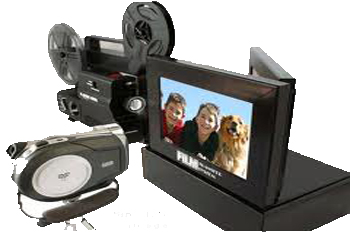
Film Conversion Equipment
Film Scanning and Film Transfer Equipment Types
The type of film scanning machine used for your 8mm, Super 8 or 16mm film conversion will have as much of an impact on the quality you receive as the resolution of the scan itself will. For example, if you wanted to digitize a photograph and tried doing it two different ways. You first put the photograph down on a table and took a picture of it using your smart phone or camera. Then you took the picture and scanned it using a flatbed scanner. If you compare the two side by side on your computer it will become really obvious that the flatbed scanner produced a digital image as good as the photograph. However, the picture you took with your phone or camera does not look close to the quality of the original photograph.
The same goes for scanning your 8mm, Super 8 or 16mm film. The real-time and frame by frame machines below are using a camcorder to take a picture of your film. The motion picture film scanner and Datacine machine are scanning the film. The results will be significantly different.
Film Conversion Equipment |
|
Real Time
|
|
Frame by Frame
|
|
Professional Film Scanners
|
|
Equally important as resolution is the type of film transfer. There are a few basic types of film transfer processes. More than 80% of the companies out there today use a real-time transfer. Any type of real-time film transfer will result in video that is 40-50% worse than the film’s current condition.
So, at this point you’ve learned that film transfers can capture at standard definition (480 lines), high definition (1080 lines) or 2K (1556 lines). You’ve also learned about the 3 different types of film transfers being used today. In order from least to best quality we have:
Cambridge Fun Facts: Cambridge is bordered by the city of Boston, located on the other side of the Charles River just 3 miles to the southeaSt Other surrounding communities include Somerville (to the north), Watertown (to the west), and Arlington (to the northwest). Settled in 1630 by a band of Puritans from England, Cambridge was originally called "Newtowne". The founding of Harvard College in 1636 prompted the choice of a new name, one more appropriate for a college town in New England. The name "Cambridge" was chosen due to the familiarity of many of the settlers with Cambridge University in England.
Massachusetts Fun Facts: Boston, the state capital, was a hotbed of activity, including the Boston Massacre and the Boston Tea Party, during the American Revolution. In addition to its revolutionary spirit, the state is known for sparking the American Industrial Revolution with the growth of textile mills in Lowell, and for its large Irish-American population. One of the original 13 colonies and one of the six New England states, Massachusetts (officially called a commonwealth) is known for being the landing place of the Mayflower and the Pilgrims. English explorer and colonist John Smith named the state for the Massachuset tribe.








